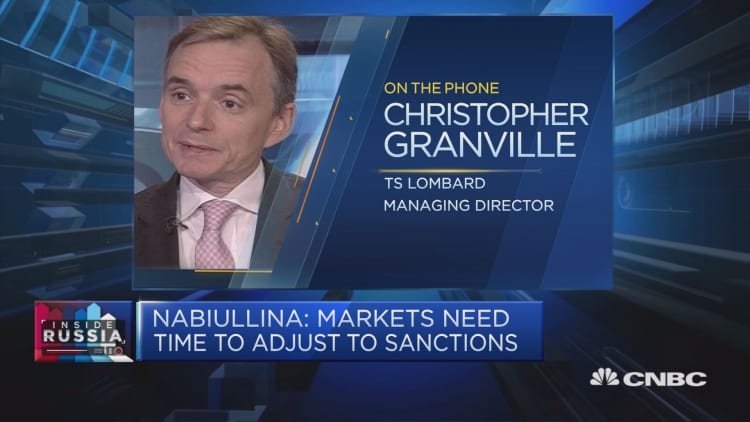Russian assets, in recovery mode following a deep recession after the global oil price collapse in 2015, have been ravaged since Friday over fears of U.S. sanctions.
Popular among many emerging market investors for the past year, this progress now appears on the brink of becoming undone as market analysts call for a re-evaluation of Russia's risk pricing.
The turmoil was triggered by the U.S. Treasury's announcement last Friday of targeted penalties on Russian entities and individuals, stemming from Congressional legislation — passed last August — known as CAASTA (the Countering American Adversaries Through Sanctions Act).
Until recently considered a safe bet, with many investors "overweight" on Russian assets, the country's markets now appear at the mercy of the U.S. Treasury, whose deployment of punitive economic measures Friday was its most severe yet.
Monday saw Russian stocks suffer their worst day since 2014, with the country's main share index crashing 11.4 percent and the ruble falling 4.5 percent against the dollar. The same day witnessed Russia's 50 richest businessmen lose close to a combined $12 billion, according to Forbes.
Russian assets will likely now be plagued by higher risk premiums after a period of long positioning on Russian risk, according to Tim Ash, senior portfolio strategist at Bluebay Asset Management. This is thanks to the market being "long overly sanguine on Russia geopolitical risk and sanctions." Indeed, for the past several years, analysts recall geopolitics having little to no lasting effect on global stocks.
Russia was an attractive proposition as it embarked on its economic recovery, said Valentijn Van Nieuwenhuijzen, chief investment officer at NN Investment Partners. "Over the last six to nine months, there have been times we actually liked Russian markets on the back of recovering commodities and oil prices," he told CNBC's Squawk Box on Tuesday.
But the danger posed to assets in the face of an unpredictably aggressive sanctions agenda changes things. "I think this type of news makes it at this point not a very attractive value opportunity," Van Nieuwenhuijzen said.
Unpredictable and unrelenting
The U.S. Treasury handed down the penalties on seven Russian oligarchs, 12 businesses and 17 Russian government officials, in response to what it described as their involvement in Russia's "malign" activities, ranging from military involvement in Ukraine and Syria to cyber crimes and alleged interference in the 2016 U.S. election.
The sanctioned entities now fall under the label of Specially Designated Nationals (SDN), which means their U.S. assets are frozen and U.S. entities are forbidden from doing business with them.

The two most lethal elements of the Treasury's package may be the reach of its secondary sanctions, and the threat that no oligarch is safe from them. Secondary sanctions can penalize non-U.S. entities doing business with the sanctioned individuals and businesses, in effect deterring investors around the world, not simply Americans, from doing business with the sanctioned Russians and their firms.
And the fact that some of the oligarchs compromised are particularly close friends of Russian President Vladimir Putin, including billionaire metals magnate Oleg Deripaska, has many in the country's elite on edge. Several of these individuals are powerful players in bringing Western funding into the country — once sanctioned, their access to international financial markets is severely crippled.
'Real game-changing events'
As an example, the country's leading aluminum producer Rusal, which is owned by Deripaska, lost a staggering 50 percent of its share price value Monday after the oligarch was put on the SDN list. It may now be forced to default on its debt to international lenders if not bailed out by the Russian government.
"The fact that the U.S. Treasury rolled out secondary sanctions and also hit some big name oligarchs (are) the real game changing events, which I think risks re-pricing Russia risk on a more permanent basis," Ash said. "I think you have to look at Russia through a different risk prism now as a result of the (Treasury) actions on April 6."
It is yet to be seen how the Kremlin will respond, but the market reaction in the coming days may very well depend on whether there is an easing or heightening of tensions between the two adversaries. Russia and the U.S. are in the midst of what Russian experts have described as the worst relations since the Cold War.
"The message from the U.S. Treasury is don't expect the U.S. government to pull many punches here in its battle for geopolitical hegemony with Russia," Ash said. "And investors invest in Russia at their own risk, don't expect some kind of U.S. government backstop."


